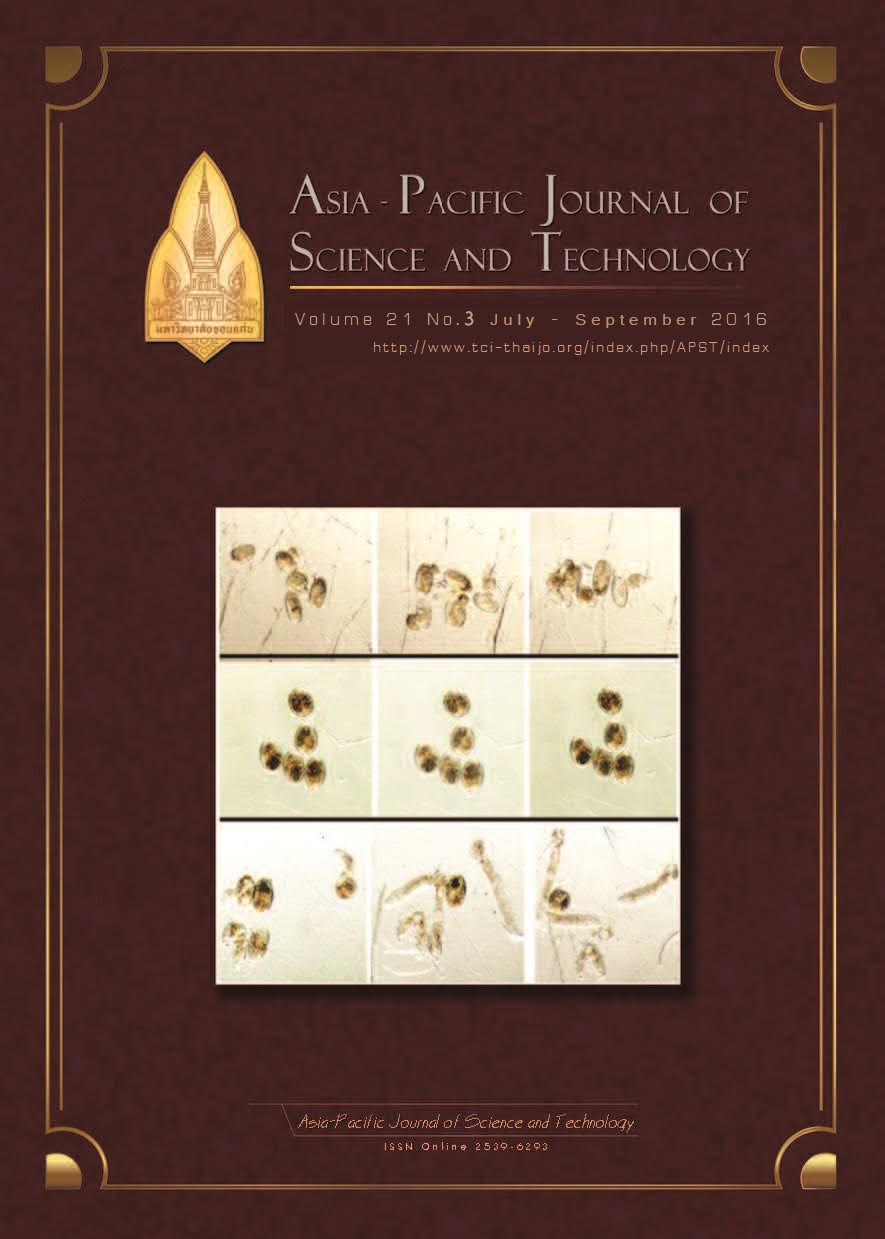Microbial and physical-chemical properties as influenced by land use change in the conversion of cassava into rubber tree plantation system
Main Article Content
Abstract
Land use change and agricultural management practices could have an impact on soil properties and quality. The aim of this study was to evaluate the effect of land use change from the previous crop (cassava) to a rubber tree chronosequence on soil quality related to microbial and physical-chemical properties. Microbial properties together with physical-chemical properties, including microbial biomass carbon, soil respiration, microbial quotient (qmic) and microbial metabolic quotient-C (qCO2), which have been considered as effective indicators of the changes in soil quality, were examined. Soil total nitrogen, available phosphorus and exchangeable potassium content were higher in the rubber tree plantation than the cassava plantation, suggesting an improvement in soil microbial biomass efficiency. The highest qmic was found in 11 years rubber tree plantation which indicates most efficiency of converting organic carbon into microbial biomass carbon or carbon losses in soil. Interestingly, no significantly different of qCO2 was found among treatments. These findings suggested that soil quality related to microbial properties was not responsive to land use change from cassava to rubber tree.
Article Details
References
(1) Rubber Research Institute of Thailand. Statistic. [Internet] 2015 Aug 25. Available from: http://www.rubberthai.com/statistic/stat_index.htm. Thai.
(2) Jing-cheng Y, Jian-hui H, Qing-min P, Jian-wei T, Xing-guo H. Long-term impacts of land- use change on dynamics of tropical soil carbon and nitrogen pools. J Environ Sci. 2004;16(2):256-261.
(3) de Blécourt M, Brumme R, Xu J, Corre MD, Veldkamp E. Soil Carbon Stocks Decrease following Conversion of Secondary Forests to Rubber (Hevea brasiliensis) Plantations. PloS One.2013;8(7):e69357
(4) Jiang YJ, Yuan DX, Zhang C, Kuang MS, Wang JL, Xie SY, et al. Impact of land use change on soil properties in a typical karst agricultural region of Southwest China: a case study of Xiaojiang watershed, Yunnan. Environ Geol. 2006;50(6):911-918.
(5) Hartemink AE, editors. Land use change in the tropics and its effect on soil fertility. Proceedings of the 19th World Congress of Soil Science, Soil Solutions for a Changing World; 2010 Aug 1-6; Brisbane, Australia.
(6) Bruun TB, Neergaard A, Lawrence D, Ziegler AD. Environmental Consequences of the Demise in Swidden Cultivation in Southeast Asia: Carbon Storage and Soil Quality. Hum Ecol. 2009;37(3): 375–388.
(7) Kennedy AC, Papendick RI. Microbial characteristics of soil quality. J Soil Water Conserv. 1995;50(3):243-428.
(8) Srivastava SC, Jha AK, Singh JS. Changes with time in soil biomass C, N and P of mine spoils in a dry tropical environment. Can J Soil Sci. 1989;69(4):849-855.
(9) Smith L, Paul EA. The significance of soil microbial biomass estimations. In: Bollag JM, Stotzky G, editors. Soil biochemistry. New York: Dekker; 1990. p. 357-396.
(10) Araújo ASF, Santos VB, Monteiro RTR. Responses of soil microbial biomass and activity for practices of organic and conventional farming systems in Piauí state, Brazil. Eur J Soil Biol. 2008;44(2):225-230.
(11) Wardle DA, Ghani A. A critique of the microbial metabolic quotient (qCO2) as a bioindicator of disturbance and ecosystem development. Soil Biol Biochem. 1995;27(12):1601-1610.
(12) Bremner JM. Determination of nitrogen in soil by the Kjeldahl method. J. Agr. Sci. 1960;55(1):11-33.
(13) Bray RH, Kurtz LT. Determination of total, organic, and available forms of phosphorus in soils. Soil science. 1945;59(1):39-45.
(14) Walkley A, Black IA. An examination of the Degtjareff method for determining soil organic matter, and a proposed modification of the chromic acid titration method. Soil science. 1934;37(1):29-38.
(15) Promruksa W, Smakgahn K. Carbon stock in soil rubber plantation. J Appl Phytotechnol Environ Sanit. 2014;3(3):101-107.
(16) Amato M, Ladd JN. Assay for microbial biomass based on ninhydrin reactive nitrogen in extracts of fumigated soil. Soil Biol Biochem. 1988;20(1):107–114.
(17) Sparling GP, West AW. A direct extraction method to estimate soil microbial C: calibration in situ using microbial respiration and 14C labeled cells. Soil Biol Biochem. 1988;20(3):337-343.
(18) Anderson JPE. Agronomy monograph number 9, part II. In: Page AL, Miller RH, Keeney DR, editors. Chemical and biological properties. Madison: American Society of Agronomy and Soil Science Society of America; 1982. p. 831–871.
(19) Murbach MR, Boaretto AE, Muraoka T, de Souza ECA. Nutrient cycling in a RRIM 600 clone Rubber plantation. Sci Agric. 2003;60(2):353-357.
(20) Puttaso P, Pnomkhum P, Rungthong R, Promkhambut A, Kaewjampa N, Lawongsa P. Microbial biomass and activity under different ages of rubber tree plantations in northeast Thailand. Khon Kaen Agr J. 2015;43 Suppl 1:S963-967.
(21) Zhang M, Fu X, Feng W, Zou X. Soil organic carbon in pure rubber and tea-rubber plantations in South-western China. Tropic Ecol. 2007;48(2): 201-207.
(22) Anderson JM, Domsch KH. Application of ecophysiological quotients (qCO2 and qD) on microbial biomass from soils of different cropping histories. Soil Biol Biochem. 1990;22(2):251-255.
(23) Sparling GP. Soil microbial biomass, activity and nutrient cycling as indicators of soil health. In: Pankhurst C, Doube BM, Gupta VVSR, editors. Biological indicators of soil health. Cambridge: CAB Int; 1997. p. 97-120.


